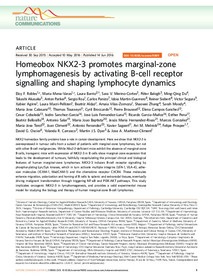Benvinguts al Repositori Digital de la UPF
Homeobox NKX2-3 promotes marginal-zone lymphomagenesis by activating B-cell receptor signalling and shaping lymphocyte dynamics.
JavaScript is disabled for your browser. Some features of this site may not work without it.
Mostra el registre parcial de l'element
| dc.contributor.author | Robles, Eloy F. |
| dc.contributor.author | Bellosillo Paricio, Beatriz |
| dc.contributor.author | Salar Silvestre, Antonio |
| dc.contributor.author | Martinez-Climent, Jose A. |
| dc.date.accessioned | 2016-12-22T09:21:16Z |
| dc.date.available | 2016-12-22T09:21:16Z |
| dc.date.issued | 2016 |
| dc.identifier.citation | Robles EF, Mena-Varas M, Barrio L, Merino-Cortes SV, Balogh P, Du MQ. et al. Homeobox NKX2-3 promotes marginal-zone lymphomagenesis by activating B-cell receptor signalling and shaping lymphocyte dynamics. Nat Commun. 2016 Jun 14;7:11889. doi: 10.1038/ncomms11889 |
| dc.identifier.issn | 2041-1723 |
| dc.identifier.uri | http://hdl.handle.net/10230/27820 |
| dc.description.abstract | NKX2 homeobox family proteins have a role in cancer development. Here we show that NKX2-3 is overexpressed in tumour cells from a subset of patients with marginal-zone lymphomas, but not with other B-cell malignancies. While Nkx2-3-deficient mice exhibit the absence of marginal-zone B cells, transgenic mice with expression of NKX2-3 in B cells show marginal-zone expansion that leads to the development of tumours, faithfully recapitulating the principal clinical and biological features of human marginal-zone lymphomas. NKX2-3 induces B-cell receptor signalling by phosphorylating Lyn/Syk kinases, which in turn activate multiple integrins (LFA-1, VLA-4), adhesion molecules (ICAM-1, MadCAM-1) and the chemokine receptor CXCR4. These molecules enhance migration, polarization and homing of B cells to splenic and extranodal tissues, eventually driving malignant transformation through triggering NF-κB and PI3K-AKT pathways. This study implicates oncogenic NKX2-3 in lymphomagenesis, and provides a valid experimental mouse model for studying the biology and therapy of human marginal-zone B-cell lymphomas. |
| dc.description.sponsorship | This work was supported by Grants from the Instituto de Salud Carlos III (ISCIII), Spanish Ministry of Economy and Competitiveness, FIS-PI12/00202 (to J.A.M.-C.), RTICC-RD12/0036/0063 (to J.A.M-C.), RTICC-RD12/0036/0068 (to M.J.C and F.P.), RTICC-RD12/0036/0022 (to J.L.F-L.), RTICC-RD12/0036/0070 (to J.C.), RTICC-RD12/0036/0010 (to B.B.), RTICC- RD12/0036/0044 (to M.J.B.) and RTICC-RD12/0036/0069 (to J.M.H.R. and M.G.); by Worldwide Cancer Research project grant 15-1322 (to J.A.M.-C., Y.R.C. and M.-Q.D.); by BFU2011-30097 (to Y.R.C); by MINECO SAF2013-45787-R and Marie Curie Programme FP7-PIIF-2012-328177 (to S.R.); by the French-Spanish CITTIL project (to F.P., X.A., J.A.M.-C., C.B. and P. Brousset); by SAF2012-32810, SAF2014-57791-REDC; PIE14/00066, BIO/SA32/14 and CSI001U14 (to I.S.G); by FIS-ISCIII projects PI13/00160 and PI14/00025, and Fundación Inocente Inocente (to C.C.); by Deutsche Krebshilfe, Molecular Mechanisms in Malignant Lymphomas Network Project (to R.S.); by the Institut Universitaire de France (to P. Brousset); by the Broad Medical Research Program of The Eli and Edythe Broad Foundation and the Hungarian Scientific Research Fund (OTKA K108429) (to P. Balogh); by pre- and post-doctoral fellowships from the Foundation for Applied Medical Research (to M.M.V. and E.F.R., respectively); and by a post-doctoral fellowship from the Basque Government (to I.M.-G.). All Spanish funding is co-sponsored by theEuropean Union FEDER program |
| dc.format.mimetype | application/pdf |
| dc.language.iso | eng |
| dc.publisher | Nature Publishing Group |
| dc.relation.ispartof | Nature Communications. 2016 Jun 14;7:11889 |
| dc.rights | © 2016, Nature Publishing Group, a division of Macmillan Publishers Limited. All Rights Reserved. This work is licensed under a Creative Commons Attribution 4.0 International License. The images or other third party material in this article are included in the article's Creative Commons license, unless indicated otherwise in the credit line; if the material is not included under the Creative Commons license, users will need to obtain permission from the license holder to reproduce the material. To view a copy of this license, visit http://creativecommons.org/licenses/by/4.0/ |
| dc.rights.uri | https://creativecommons.org/licenses/by/4.0/ |
| dc.subject.other | Càncer -- Aspectes moleculars |
| dc.subject.other | Proteïnes |
| dc.title | Homeobox NKX2-3 promotes marginal-zone lymphomagenesis by activating B-cell receptor signalling and shaping lymphocyte dynamics. |
| dc.type | info:eu-repo/semantics/article |
| dc.identifier.doi | http://dx.doi.org/10.1038/ncomms11889 |
| dc.relation.projectID | info:eu-repo/grantAgreement/EC/FP7/328177 |
| dc.relation.projectID | info:eu-repo/grantAgreement/ES/3PN/BFU2011-30097 |
| dc.relation.projectID | info:eu-repo/grantAgreement/ES/1PE/SAF2013-45787-R |
| dc.rights.accessRights | info:eu-repo/semantics/openAccess |
| dc.type.version | info:eu-repo/semantics/publishedVersion |


